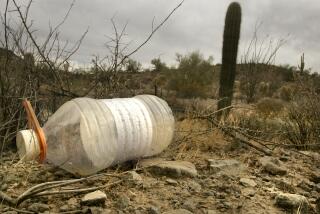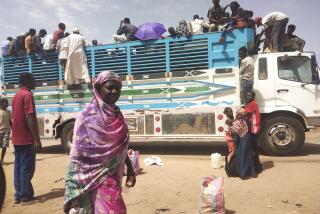A Day In The Life Of Mother Earth : The Sands of Timbuktu : ‘Before, there had been many droughts. . . . But this last one changed us.’ Mohamed Aly Alamine, <i> former herder</i>
- Share via
TIMBUKTU, Mali — * The Problem--Desertification
* The U.N. View--”The overuse of marginal land for farms and livestock causes a cycle of desertification and poverty. . . . Desertification affects one-fourth of the Earth’s land area and one-sixth of its people.”
* The Case Study: Mali--The legendary outpost of Timbuktu stands at the very edge of the advancing Sahara Desert.
Mohamed Aly Alamine lived all his life in the desert among herds of camels and goats and according to an ancient annual cycle of rainfall and drought.
He knew by 40 years of experience and the lessons of his father how many animals a man needed to sustain himself through the dry times. In a good year, when the animals stayed healthy and fat, he could leave some of them with farmers occupying the savannah to the south, where they could graze and fertilize the fields until drought so reduced his own herds that he needed to redeem them from the borrowers.
But now he lives in the city, in a mud hut with a galvanized-tin roof on the outskirts of Timbuktu. In a pen behind the house he keeps 20 scrawny goats, a vestige of the more than 100 he once grazed over a boundless savannah along with a herd of camels. He lives off these, as well as a few francs earned showing tourists around the ancient oasis city and handouts from family members.
“In the desert you had everything you needed,” he says. “Goats, milk and millet. The nomadic life was a simple life. In the city you just need money. Everything’s money, money.”
Mohamed Aly reclines on a reed mat laid over the soft sand floor of his hut, watching two grandchildren roast nuts on a wood stove. It’s only noon, but he has already spent a few hours amid the ankle-deep sand of Timbuktu’s main street, passing the time with the city’s curio-sellers dependent on a vanished trade.
In the past, this time of year would have found him somewhere in the vast northern wastes of Mali or Niger with his herds, communing with other herders he met on the way. But the loss of his animals and other changes in his society--all traceable ultimately to the destruction of the land--have reduced him to living in a claustrophobic hut.
The former herder is barely 50, but a face crevassed with lifelong exposure to the sun and windblown sand makes him look 70. Members of the nomadic tribes of the Sahel, the “shore” of the sandy sea known as the Sahara, carry generations of history with them whatever their age.
“Before, there had been many droughts,” he recalls. “My father told me of one 60 years before. But this last one changed us.”
The last major drought to strike the Sahel occurred in 1985, with devastating consequences for the nomadic herders who had ranged the semi-arid terrain for centuries. But it was more than a climatic phenomenon of limited duration; instead, it was a symptom of the decades-old process of desertification.
More than a half-century of ill-advised development schemes, and even the introduction of modern science with its overconfidence in its ability to outsmart God and Nature, have changed what was once a thinly vegetated region able to sustain a widely dispersed nomadic population into a vacant land overtaken by the Sahara. Almost nobody regards the change as temporary; in the words of one student of the nomadic tribes of this part of Africa: “Their very mode of life is disappearing progressively.”
The proximate agents of this change were two historic droughts, in 1973 and 1985, that provoked famines worse than most living nomads could remember.
This is not to say that drought and famine were ever unfamiliar companions to the nomads of the Sahel. As recently as 1975 there were people who could remember pre-colonial famines by name: “There was the ‘sale of children’ famine (they sold those they could no longer feed), ‘the grinding up of the water gourd’ (in order to eat it), and the Yollo Morou, ‘sit and stroke your plaits’ (for no more could be done),” wrote the environmentalist Patrick Marnham around that time.
“The peculiar achievement of nomadic pastoralism in the Sahel,” Marnham observed, “was to make human occupation a possibility at all.”
But the events of recent years suggest that this achievement depended on accepting that Nature alone, by her pitiless and implacable imposition of death and disease on animal and man, may be able to keep the numbers of creatures ranging the Sahel at a sustainable equilibrium.
Instead, colonial administrations in the Sahel attempted to extract more from the land than it could give. French colonialists, whose jurisdiction extended halfway across the African continent, envisioned development of the great bend of the Niger River as an agricultural paradise. As long ago as the 1930s they were encouraged by the infiltration of Western advances in veterinary and medical health into the remote range of the nomads.
By 1938 the first signs of desertification had surfaced: Larger and stronger herds caused overgrazing. Programs to turn nomads into settled farmers caused deforestation and over-cultivation of the thin soil. What was being demonstrated was that the only suitable use for the meager resources of the Sahel was the low-impact pastoring of small herds.
Many experts are coming to believe that ignorance of this limitation was what aggravated an ancient cycle of rainfall and drought into the unexampled disasters of the 1970s and ‘80s. The testimony of local people suggests that external conditions, not solely the weather, were what made the recent droughts so severe.
“Every old person here knows that in this year or that, there was a drought. But they’d be regional, not general,” says Mohamed Zouber, a teacher among the Malian nomads.
Nevertheless, development schemes encouraged herders to invest in larger and larger herds, often by going into debt. The idea was to provide meat for city-dwellers, but the introduction of commercial-scale herding to the Sahel hastened its deterioration. Where once rainfall and the availability of pasture were the factors dictating the size of herds, now it was the demands of creditors and the beef markets in places as far away as Dakar, on the Senegal coast.
Not only the environment was doomed by this revolution; also destroyed was the nomadic tribes’ very social structure--a graphic example of how more than health is dependent on ecology.
The historic droughts of the 1970s and 1980s sent younger nomads fleeing for their livelihoods to Libya, Algeria and Mauritania, and older ones to cities to beg. When the youths eventually returned, they came with firearms and education acquired during stints in Moammar Kadafi’s army, and a parallel disinclination to accept “the traditional leadership of noble geriatrics,” in the words of one close observer of the people. The resulting crisis of leadership and civil insecurity along the Sahel has restricted the ability of development agencies to design and implement remedial programs.
For all that, much of the development effort taking place on the edges of the desert is aimed at seeking a solution to what strikes most people as an exceptionally harsh and unforgiving natural cycle.
Development workers argue that it is their duty and the world’s to ameliorate Nature’s limitations on such a lifestyle.
“What do you do if people are dying?” asks Daniel Coulibaly, head of a World Vision International project to enhance water resources for Sahel nomads in Mali. “Do you just leave them to die?”
Today, development officials recognize that man cannot unilaterally breach limits imposed by nature, but the solution of choice for the plight of the nomads in desertified areas is still to move them gradually into a form of quasi-settled agriculture.
The problem is that people raised in the nomadic tradition are repelled by the thought of farming.
“We’re just nomads,” says Mohamed Aly Alamine. “We know the animals and we don’t like agriculture. We find it difficult. But in the year of the drought, everybody lost their herds. Now we’ve come to the city and we cannot go back.”
More to Read
Sign up for Essential California
The most important California stories and recommendations in your inbox every morning.
You may occasionally receive promotional content from the Los Angeles Times.










